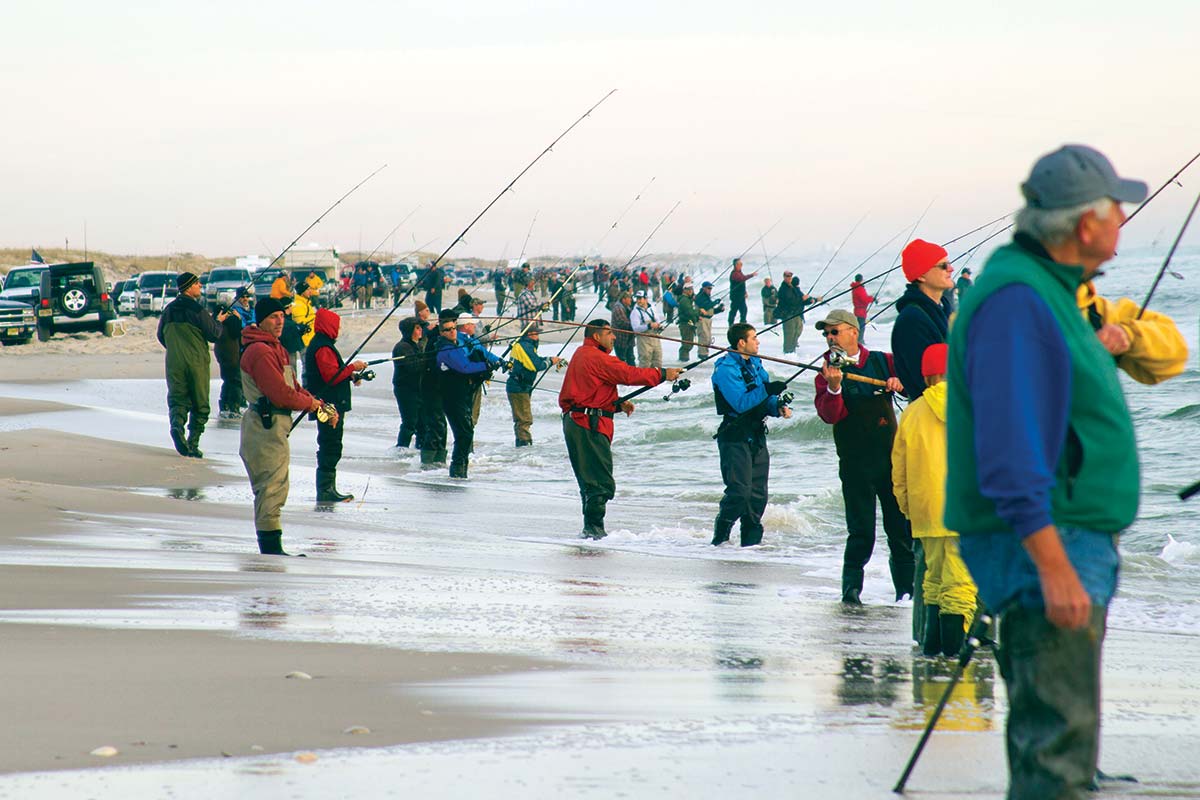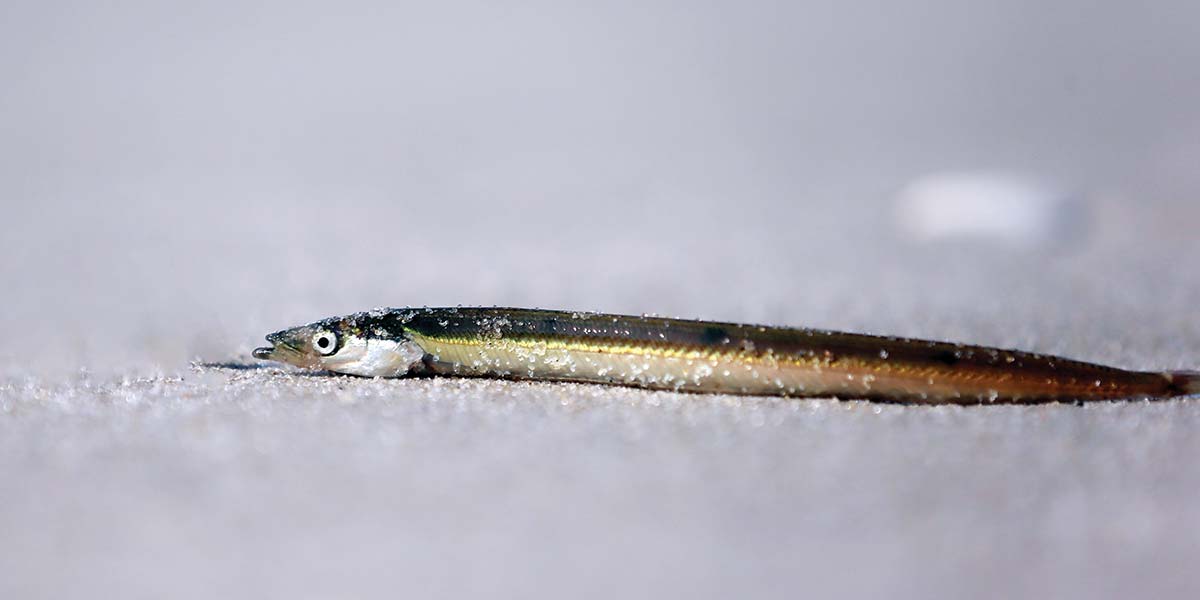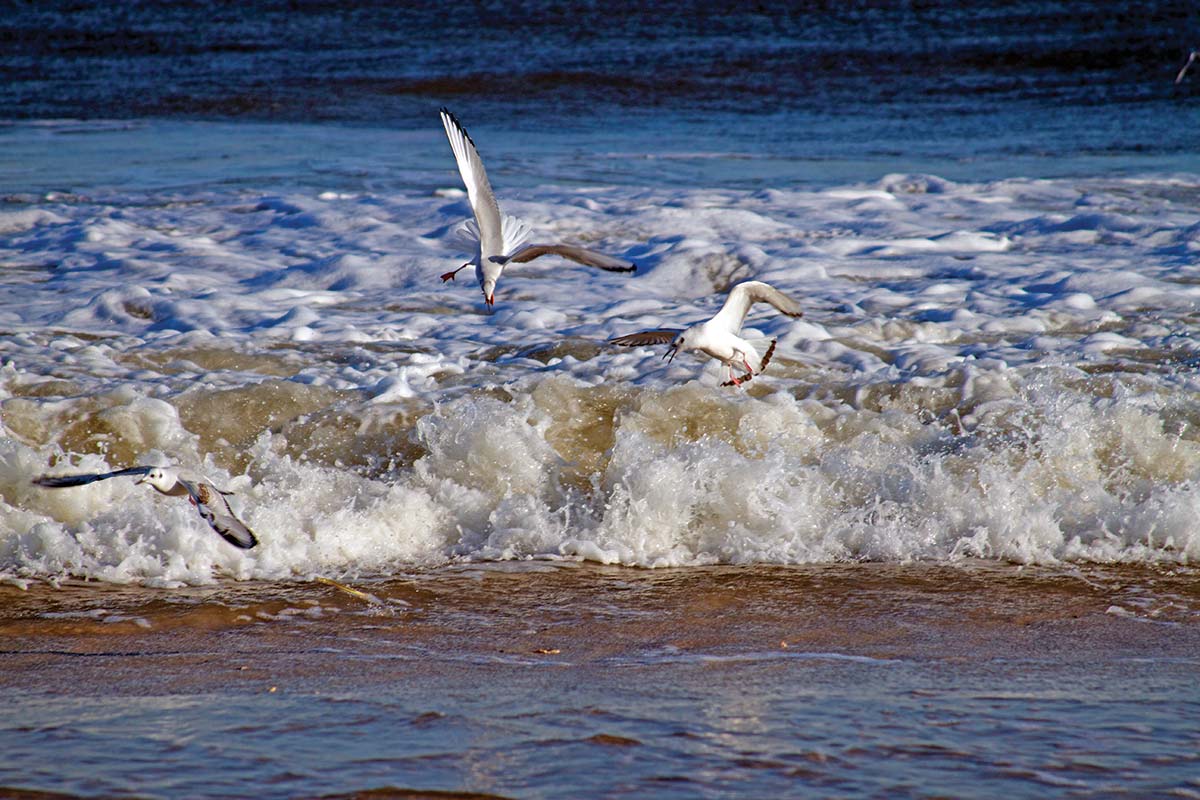Photos by Tom Lynch

What does the immediate future hold for sand eels in the striper surf?
Every year as I gear up for the fall striper run I find myself hoping for another sand eel bite at the Jersey Shore, like the memorable one in 2011. As a reminder, I often gaze at photographer Tom Lynch’s iconic picture of anglers lined up elbow to elbow along the sand at Island Beach State Park more than a decade ago. As Tom notes “It was a banner year! Sand eels flooded the surf zone in the early fall fueling spectacular striper fishing day after day through the end of the year.”
From the beaches of Cape Cod, down the South Shore of Long Island, to my home turf here in the Garden State, the big question every fall is whether or not that “banner” of bass and bait gets waved again in tight to the beach.
A Spectacle Of Sand Eels
Worldwide, taxonomists recognize some 27 species of sand eels, also known as sand lances, from inshore and offshore waters of temperate oceans. Inshore, sand eels are primarily found in shallow coastal waters and estuaries. Offshore they typically congregate over offshore shoals and sand banks. Their habitats of choice are comprised of clean, coarse sand, or sand with crushed shell or fine gravel that is soft enough to accommodate burial and can hold enough oxygen to facilitate respiration
Although morphological similarities make it difficult to differentiate between species, two species of sand eels are considered common along the Northeast coast of the United States. The American sand eel (ammodytes americanus) is considered to be the dominant inshore species with a geographic range extending from Newfoundland and northern Labrador south to the Chesapeake Bay area. The northern sand eel (ammodytes dubius) comprises the bulk of the sand eels typically found in deeper coastal and offshore continental shelf waters from Greenland to Cape Hatteras. However, there is evidence suggesting that there is some seasonal overlap between populations with fluxes of northern sand eels towards inshore coastal waters in summer and American sand eels to deeper water in winter months.
At times along the striper coast sand eels can be locally abundant in one area while seemingly absent in others. The sudden appearance and disappearance of sand eels along the beach is partially tied to the fact that they alternate between periods of inactivity when they are buried several inches into the substrate to avoid predation, particularly at night, and periods of activity when they emerge and form dense schools while feeding in the water column. Peaks in foraging begin soon after dawn with a secondary peak towards evening prior to dusk, after which they burrow into the sand again at night.
This spectacle was highlighted by eminent ichthyologist George Brown Goode in his 1884 monograph on The Natural History of Useful Aquatic Animals, in which he noted that while digging clams in Provincetown Harbor one morning, he saw “a great section of beach become alive with dancing forms of dozens and dozens of agile fish” that turned out to be schooling sand eels emerging from the sediment.

Distribution & Abundance
Sand eel populations have fluctuated over the years, but comprehensive scientific information about what drives sand eel distribution and abundance at a regional scale in the Western North Atlantic is limited.
Spawning success is certainly one factor contributing to boom or bust years of sand eel abundance. Sand eels spawn during fall and winter, beginning sometime in late November, peaking from December to January and ending by February or March. Spawning is believed to be widespread over sandy bottoms and offshore shallow banks along the continental shelf. Larvae are dispersed by currents along the shelf and into coastal waters where, after about four to five months, they transform into juveniles and eventually begin the habit of burrowing into sandy substrates to avoid predation.
Unfortunately, preliminary evidence from recent studies designed to understand how sand eels and other species will respond to changes in environmental variables driven by climate change have identified two factors that will have an impact on future spawning success, ocean surface temperatures and ocean acidification. For example, the results of experiments that exposed eggs and larvae collected from sand eels in the North Sea to predicted future ocean temperature conditions suggest that warming ocean waters will have a negative impact on larval development and survival which may, in turn, affect long-term reproductive output and result in lower annual recruitment.

Results of another recent experiment on offspring of northern sand eels suggest that in addition to sensitivity to temperature increases sand eel spawning success is similarly vulnerable to impacts associated with ocean acidification. In this study, exposure to acidified conditions predicted to occur under various ocean warming scenarios negatively affected embryonic growth and reduced hatching success supporting this conclusion.
Predation undoubtedly also contributes to sand eel population fluctuations. Dubbed the quintessential forage fish in the Northern Hemisphere, the sand eels importance in the food chain cannot be overstated. As noted by Woods Hole marine scientists Henry Bigelow and William Schroeder in their 1953 tome Fishes of the Gulf of Maine “the sand eel plays a very important role in the economy of northern seas as food for a variety of larger animals.” In fact, aside from being a favored striper prey, over 40 species of fish, a dozen marine mammals, and dozens of coastal and marine birds readily consume considerable quantities of sand eels.
Prey availability is another factor impacting sand eel distribution and abundance. The diet of sand eels is comprised of seasonally available, locally abundant, lipid-rich zooplankton. In particular, the copepod (calanus finmarchicus) is their favored prey item. As marine biologist Sir Alister Hardy noted in his 1965 book The Open Sea: The World of Plankton “stretching through the vast oceans for thousands and thousands of miles in every direction, the crustaceans of the marine plankton par excellence are the copepods and those of the genus Calanus are particularly important as the preferred prey of many important fishes in the Northern Hemisphere”.
However, over the past several decades scientists have documented a progressive northward shift in the range of zooplankton assemblages in response to warming sea surface temperatures, including the sand eel’s favored prey, calanoid copepods. These projected changes in the distribution of Calanus could create a scenario where peaks in copepod abundance do not coincide with sand eel distribution, forcing sand eels to forage on lesser quality prey which could decrease their overall fitness.
Furthermore, it seems that in warmer water copepods grow faster, are physically smaller at maturity, and run through their energy stores more quickly due to increased metabolism. As a result, copepods associated with warmer water are likely to have lower energy reserves which could also directly affect sand eel fitness by providing less nutritional value.

Impacts Of Beach Replenishment
Along the Jersey Shore since the 1990’s, over 200 million cubic yards of sand have been pumped onto beaches in the name of shore protection at a cost of over $2 billion dollars. Along the Monmouth and Ocean County coast in particular during the past decade, the frequency of beach replenishment has dramatically increased since Superstorm Sandy hit in the fall of 2012.
Many seasoned striper anglers in New Jersey feel that the sand eel bite hasn’t been the same since 2011 and speculate that sand eel abundance along the beaches has been impacted by the current pace and magnitude of beach replenishment projects. The sand being pumped onto local beaches comes from a number of locations offshore referred to as ‘sand resource areas’ which are designated through a Federal-State cooperative agreement between the Army Corps of Engineers and New Jersey Department of Environmental Protection (NJDEP).
As supplies of sand from inshore sand resource areas become tapped out, there is concern that offshore ridges, lumps, and sand banks will become new sand ‘borrow sites.’ However, sand mining operations at these sites will result in removal of hard bottom habitats that offer refuge for benthic organisms that are important forage for fishes as well as serve as essential habitat for fish species highly dependent on a sandy sediment such as sand eels.
In addition, according to New Jersey’s federally approved Coastal Zone Management Program rules, features such as rock outcroppings and sand ridges or lumps, are included in the state’s definition of ‘Prime Fishing Areas.’ Prime fishing areas are acknowledged in the rules as important congregation areas for finfish, shellfish, and invertebrate species essential to marine ecosystem functioning and permissible uses of such areas include recreational and commercial finfishing and shellfishing, scuba diving, and other water related recreational activities, not sand mining!
Regardless of the sand source when the sand is being pumped onto the beach aside from burial of benthic species and disruption of fish distribution patterns, other impacts to fish can include gill clogging, reductions in prey, and modification of sediment texture and associated changes in shelter availability. In the case of sand eels, if the sediment being used for beach fill differs from natural beach sediment it could make the substrate incompatible with their habitat requirements for clean, coarse sands.
Unfortunately, most biological assessments of the impacts of sand mining at borrow sites and beach replenishment efforts have focused on the impacts to benthic communities with limited attention being given to fish communities in or adjacent to these sites. The few studies that have included assessments of the effects of sand mining and beach nourishment on fishes have been broad-based in nature and relied on qualitative and at times anecdotal information with little attention paid to specific impacts to individual fish species other than a few deemed ‘commercially and recreationally’ valuable. The impacts of these activities on important forage species like sand eels have not been studied and remain unknown at this time.

So, What Does The Future Hold?
First, it is clear that additional research is needed to increase our knowledge of American and northern sand eel biology, life history, population dynamics, and drivers of distribution and abundance. It is also evident that our oceans are changing and further studies are necessary to better understand the sensitivity and/or adaptability of American and northern sand eels to current and future climate change scenarios. In addition, as a key prey item for numerous commercially and recreationally valuable fishes and iconic wildlife species, information on how changes in sand eel distribution and abundance will affect their predators needs consideration.
Meanwhile, while scientists continue to investigate the vulnerability of sand eels to climate driven environmental stressors and governments grapple with policy responses to climate change, opportunities exist to eliminate non-climate related stressors that are potentially impacting sand eel populations.
| ESSENTIAL FISH HABITAT |
| Although it appears that New Jersey is committed to beach replenishment as the preferred shore protection strategy, it is important to insist that future studies on the impacts of these projects be expanded to include an assessment of short-term and long-term effects on all ecosystem components, including forage species. Furthermore, the angling community must insist that the Corps of Engineers and NJDEP investigate effective alternative techniques to beach replenishment, implement fisheries-related mitigation measures for unavoidable impacts associated with beach replenishment and, most importantly, be held accountable for enforcement of the state’s coastal zone management rule regarding Prime Fishing Areas as they explore and identify additional offshore sources of sand for replenishment projects. |
For example, in 2017 sand eels were classified as ‘unmanaged forage fish’ under the Unmanaged Forage Fish Amendment developed by the Mid-Atlantic Fisheries Management Council and approved for implementation by NOAA Fisheries. This amendment will prohibit the development or expansion of a directed commercial fishery on sand eels and other listed forage species in Mid-Atlantic federal waters until the Council has had an adequate opportunity to assess the scientific information relating to how a directed fishery would impact existing fisheries, fishing communities, and the marine ecosystem.
Hopefully, their designation as an unmanaged forage species will lead to a stock assessment that yields basic biological data on sand eels as well as an accurate population assessment and analysis of factors impacting their distribution, abundance, and mortality.



